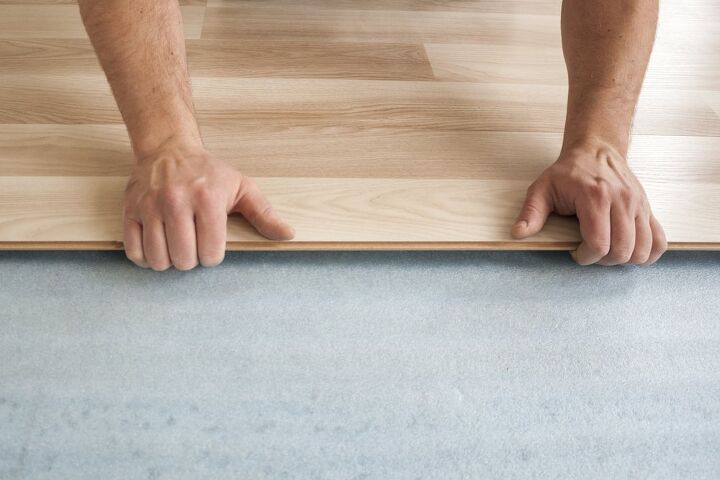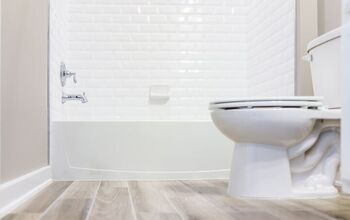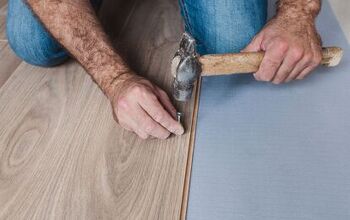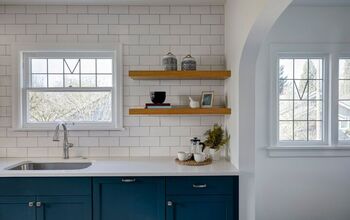Can A Floating Floor Be Glued? (Find Out Now!)

If you just installed a floating floor, you might be wondering: Can a floating floor be glued down? If you find that the pieces are shifting after installation, it can feel tempting to just grab a glue or nail gun and put an end to the shifting.
Generally, a floating floor is not intended to be glued down. If you glue a floating floor, there’s a strong chance that you’ll disrupt the natural expansion and contraction of each piece, creating a problematic lump. The grooves of luxury vinyl flooring in bathrooms and kitchens should be glued to prevent moisture from slipping through the cracks. However, that’s not the same as gluing them down.
A floating floor, true to its name, floats on the floor. When you glue it down, it’s no longer really a floating floor.
There are a few cases when it’s okay to glue down a floating floor, especially if you’re just gluing each piece together for added stability. Always check with the manufacturer of your flooring to see whether your flooring was made for this. If not, it will void your warranty.
Maybe the pieces are shifting or maybe they’re making loud clicking noises when you walk on them. Either way, in this article, we’ll talk about when you should and shouldn’t glue your floating floor.
Do You Need to Hire a Flooring Contractor?
Get free, zero-commitment quotes from pro contractors near you.

What is a Floating Floor?
A floating floor is a type of flooring that, instead of being nailed down to the floor, “floats” over the subfloor. Floating floors are usually laminate, luxury vinyl, or engineered hardwood.
They work very similarly to locking a bunch of puzzle pieces together. Once the puzzle’s finished, the pieces shouldn’t shift. They’re secured to the subflooring by their individual weight and their relationship to the other pieces.
There are three popular types of floating floors: laminate, luxury vinyl, and engineered hardwood.
Laminate Floating Floors
Laminate floating floors are a multi-layer synthetic that’s fused together through — you guessed it — lamination. The top layer is a synthetic that typically appears to be either wood or stone while the other layers provide insulation and protection.
Luxury Vinyl Flooring (LVF)
Luxury vinyl is similar to hardwood laminate, but they’re made out of 100% waterproof materials. This is why vinyl flooring is best for bathrooms, kitchens, and other areas that tend to accrue moisture.
Some luxury vinyl flooring is made to be glued together for this reason — and we’ll get into that in more detail later.
Engineered Hardwood
Engineered hardwood floors are made with anywhere between 3-12 layers of plywood, with a hardwood finish on top. They’re engineered so that, unlike traditional hardwood which needs to be glued or nailed, the pieces snap together.
Should You Glue or Nail Down Floating Floors?
Why would you want to glue down floating floors in the first place?
For one, the pieces might be shifting. Additionally, they could be noisy (making “clicking” sounds when you walk on them). Finally, you might just desire the peace of mind that your floor is more securely attached to the ground.
Whatever the reason, you should not glue or nail down floating floors unless you’re 100% sure you can do it with zero issues. Floating floors are engineered for the pieces to fit together without glue.
Why Shouldn’t You?
Even a small amount of glue in the wrong place can affect how those pieces fit together. If your floor isn’t completely level or if you accidentally make a mistake during the application, you may be looking at costly and time-consuming repair. It could be an even worse problem than before.
Gluing or nailing floating floors turns them, more or less, into permanent floors. In many cases, this voids the warranty and shortens the lifespan of the material.
Why Should You?
If, however, you still desire to glue floating floors to get rid of any shifting or squeakiness, it’s definitely possible. As long as you’re certain that the problems are caused by improper installation, you can definitely fix it this way.
Just keep in mind that it isn’t necessarily advisable. If a material isn’t meant to be glued and your manufacturer explicitly expresses that, it’s easier to just listen to the directions.
Different Types of Floating Floor Planks and When to Glue Them
Luxury Vinyl Flooring
Not all luxury vinyl flooring is made to float. In fact, for bigger areas you may want to opt for luxury vinyl flooring that’s meant to be glued down.
Loose-lay and click vinyl flooring is typically much thicker. Loose lay is usually around 5mm while vinyl flooring with a click mechanism is around 5-6mm.
Glue-down vinyl flooring, on the other hand, is much thinner. Most planks will only have a thickness of about 2-3mm.
While it may be easier to simply lay down LVF for kitchens and bathrooms, other options are available that are meant to be sturdier and more durable. Glue-down vinyl flooring is particularly appropriate for any areas that regularly experience anything heavy moving or rolling over them, like a wheelchair.
When the flooring is more securely attached to the ground, there’s virtually no risk of any individual piece warping or moving and eventually lifting. Even if a piece of a glued-down floor becomes damaged, it’s easier to isolate that individual piece than it is with a floating floor.
You also might want to buy a glue-down LVF product if there are any larger areas in your home, like living rooms, family rooms, and large living spaces. This reduces the risk of any shifting.
Laminate Flooring
The same basic rules that apply to LVF also apply to laminate: unless the product is specifically designed to be glued, it probably shouldn’t be glued. Most laminate flooring products aren’t meant to be glued (although there are probably exceptions somewhere out there).
With that said, it is always possible to glue the grooves of each piece together to prevent shifting. This isn’t the same thing as gluing it down, though.
You’re just adding adhesive to each piece to make sure that it sticks to every other piece. You’re not gluing each piece to the ground.
Engineered Hardwood
People glue hardwood floors, right? So why would it be any different for engineered hardwood?
Engineered hardwood can definitely be glued down, and it doesn’t necessarily suffer from the same problems as luxury vinyl or laminate flooring. In fact, in a lot of cases, while engineered hardwood can be floated, it is glued down.
The catch, though, is that you need to prep the area more extensively than if you were to simply float it. Make sure the surface is entirely level before gluing engineered hardwood. It isn’t necessarily as DIY-friendly. You may want to consider hiring a contractor.
The good news is that it gives you a more solid feeling and less overall shifting than the other options.
How to Glue Down Floating Floors
Not all products are meant to be glued. While it’s possible to glue them together, it isn’t always advisable. If your flooring product is not specifically designed to be glued, doing so will likely void the warranty.
It’s better to save yourself the headache and just follow the instructions. Don’t do what you shouldn’t do. It isn’t rocket science.
However, if you’re 100% dead set on gluing your floating floor, here’s how to go about it:
- Select boards that are similar in quality and condition.
- Use a clamp to hold the board in place while you apply the glue
- Press the two boards being glued together.
- Wipe off any excess glue.
- Wait 20-30 minutes for the glue to dry.
- Level the surface and make sure there’s no debris.
If, two months after gluing a floating floor that wasn’t meant to be glued, a plank warps or you notice something wrong, don’t say we didn’t warn you. The genius of floating floors lies in their simplicity.
If You’re Looking to Glue Down Floating Floors, Why Not Just Buy a Product Better Suited for Your Needs?
Maybe you’ve heard a horror story or two about floating floors and you believe that you just want to glue them down to avoid any possible issues. If you want to glue down your flooring, it’s best to just buy a product that’s meant to be glued down.
Glue Down vs. Nail Down vs Floating: Which is Better?
Maybe you’re actually looking for a type of floor that’s meant to be secured to the ground in a more direct manner, like glue down or nail down. Here are some of the pros and cons of each type of material.
Glue Down and Nail Down: Pros and Cons
What are the benefits associated with glue-down flooring? Here’s a short list:
- Able to withstand high traffic.
- Minimal risk of boards flipping up.
- For any space that experiences a high level of moisture, glue-down products ensure that no moisture will seep its way into the subfloor.
- Minimal on-going maintenance.
What are the negatives?
- More difficult to install.
- Typically more expensive.
Floating: Pros and Cons
Finally, why would you opt for floating floors?
- Is much more inexpensive. You end up saving money not only on materials but also on the installation.
- Can have just as good a look and feel as more traditional flooring.
- Lasts about 20-30 years, depending on the level of foot traffic.
- More environmentally friendly. Since you don’t need glue or other damaging adhesives, floating floors are better for the environment.
- Since the floor can expand and contract, it’s better suited to react appropriately to changes in temperature.
But what’s wrong with floating floors? If you’ve clicked on this article searching for whether or not you can glue them down, you might already have your answer…
- Floating floors can shift over time. If they were improperly installed, it’s possible for floating floors to move around.
- Could be squeaky.
- Thinner than other materials. This means that floating floors can’t be sanded. ¼” underlayment could be added to minimize any potential acoustics, however.
Do You Need to Hire a Flooring Contractor?
Get free, zero-commitment quotes from pro contractors near you.

Can a Floating Floor Be Glued?
Maybe you just installed a floating floor and it’s squeaky. Maybe you can feel the boards shifting under your feet. Or, it’s also possible that you haven’t installed any flooring yet and you’re just doing some research on whether or not a floating floor can be glued.
The short answer is kind of. A floating floor should only be glued if the manufacturer says that it can be glued. Once it’s glued, it’s technically no longer a floating floor.
Floating floors shouldn’t be glued because doing so disrupts the natural ebb and flow of each piece. One of the biggest benefits to floating floors is their ability to expand and contract with temperature changes. When you glue them to the floor, you lose that benefit.
Even worse, however, you introduce the potential for additional issues. With that said, it is definitely possible to glue your floating floor. If you’re 100% certain that any issues in squeakiness or shifting is due to improper installation and you’ve eliminated any other possibilities, it’s definitely possible to glue a floating floor.
If you desire to glue your floor, though, it’s best to buy material that was made to be glued down. If you want a mixture of both, engineered hardwood could be a good option. Beyond that, there are different types of luxury vinyl that can be glued. Laminate flooring is almost never glued down.
There are pros and cons to each method, but people tend to prefer floating floors due to their low price and ease of installation. When you’re installing new floors, keep that in mind. Don’t make the job any harder than it has to be by gluing down floating floors.

We are a team of passionate homeowners, home improvement pros, and DIY enthusiasts who enjoy sharing home improvement, housekeeping, decorating, and more with other homeowners! Whether you're looking for a step-by-step guide on fixing an appliance or the cost of installing a fence, we've here to help.
More by Upgraded Home Team



























